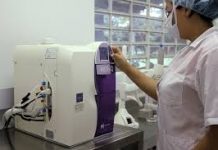August 2007 - Researchers at the University of Pennsylvania School of Medicine have discovered that a group of liver enzymes called proprotein convertases (PCs) may be the key to raising levels of good cholesterol (HDL-C). The pathway by which these proteins are able to achieve an increase in HDL cholesterol involves another enzyme that normally degrades HDL-C, and was also discovered at Penn.
The newly recognized relationship between these enzymes and cholesterol represents another target for ultimately controlling good cholesterol. The study appears in the current issue of Cell Metabolism.
"Several PC enzymes, called furin, PACE4, and PCSK5A, disable another enzyme called endothelial lipase by clipping off a piece of it and by activating its inhibitor," says first author Weijun Jin, MD, Research Assistant Professor of Pharmacology. "This promotes an increased level of HDL-C in the blood."
"We showed that mice engineered to express high levels of PCSK5A had 50 percent higher HDL-C than control mice," says senior author Daniel J. Rader, MD, the Cooper/McLure Professor of Medicine and Associate Director of the Institute for Translational Medicine and Therapeutics at Penn.
Increased HDL-C is due to decreased endothelial lipase (EL) activity. "This is encouraging because it suggests that either the PC or EL enzyme might be targets for drug therapy to raise good cholesterol, an unmet medical need in patients with low HDL-C," says Rader. What's more, the increase in HDL-C was shown to promote reverse cholesterol transport, the process by which HDL protects against heart disease.
Continue Reading Below ↓↓↓
Low levels of HDL-C put people at risk for atherosclerosis, thereby increasing the risk of heart attack and stroke. Although this study was performed in mice, humans have the same proprotein convertases and endothelial lipase, and these enzymes are conserved in all vertebrates. Jin and Rader expect that the same pathway for controlling HDL-C will apply to humans.
The next step is to study how the genes for the PCs, EL itself, and EL's inhibitor are regulated. In addition, Jin and Rader plan to test whether variation in blood levels of PCs and EL activity in humans, as well as genetic variation in their genes, is associated with variation in HDL-C levels and heart disease risk.
"We hope to identify polymorphisms in the genes for PCs, EL, and its inhibitor that are associated with HDL-C levels, thus supporting that this pathway is relevant in humans," says Rader.
Co-authors are Xun Wang, John S. Millar, and Jane M. Glick from Penn and Thomas Quertermous (Stanford University) and George H. Rothblat (Children's Hospital of Philadelphia). The study was funded by the National Heart, Lung and Blood Institute and the American Heart Association.
Source: University of Pennsylvania School of Medicine









